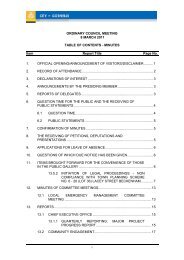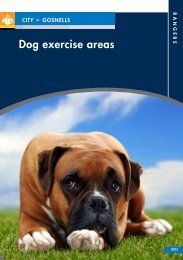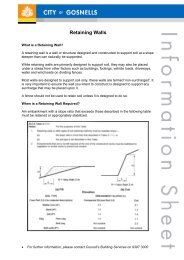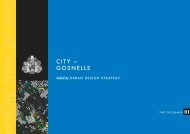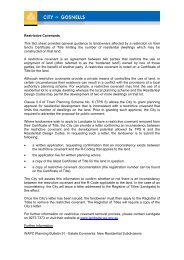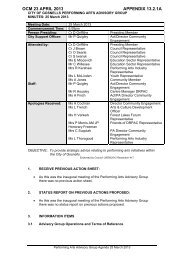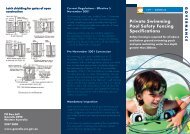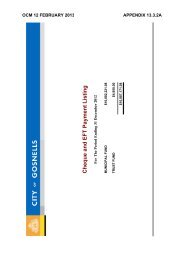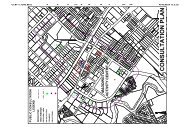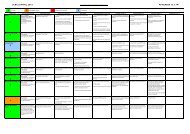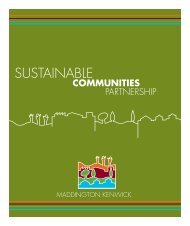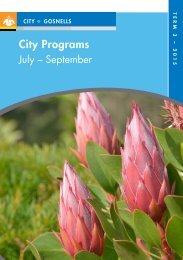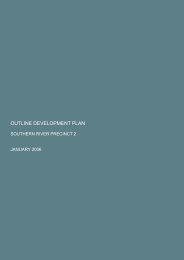Summary - City of Gosnells
Summary - City of Gosnells
Summary - City of Gosnells
Create successful ePaper yourself
Turn your PDF publications into a flip-book with our unique Google optimized e-Paper software.
Vegetation 75Table 5.6: Vegetation <strong>of</strong> the MKSEA. <strong>Summary</strong> <strong>of</strong> Floristic Community Types (FCTs) <strong>of</strong> the SCP and Conservation SignificanceVeg Unit andLocation in MKSEAVegetation DescriptionExplanatory NotesT1Site 17T1Site 28T2Site 30ST5Site 12T5Site 15T6Site 14T13M1Site 26SL1Site 19ST3Site 21ST4Sites 9,10 & 20SL3Site 4ST6Site 5Eucalyptus (Corymbia) calophylla – Kingia australis woodlands on heavy soils <strong>of</strong> the Swan Coastal Plain (FCT 3a). CONSERVATION STATUS: EPBC EndangeredCorymbia calophylla low woodland to low open forest over XanthorrhoeaFloristic analysis unequivocally assigned this vegetation to FCT 3a. Muchea Limestone ispreissii and/or Kingia australis, low shrubs and Cyathochaeta avenaceaalsopresent throughout this area (see Sites 19 and 26).Mesomelaena tetragona rushes and sedges.Corymbia calophylla low open forest over Kingia australis, Xanthorrhoeapreissii, Hakea ceratophylla, Pericalymma ellipticum open shrubs andCyathochaeta avenacea-Mesomelaena tetragona open sedges.Corymbia calophylla low open forest over open Xanthorrhoea preissii andopen Anarthria laevis - Cytogonidium leptocarpoides rushes and sedges.Hakea trifurcata open scrub over patchy Hypocalymma angustifolium-Xanthorrhoea preissii closed heath over mid- dense Mesomelaenatetragona- Chordifex sinuosus- Cyathochaeta avenacea sedges.Floristic analysis, Guildford Formation stratigraphy, and high abundance <strong>of</strong> Kingia australisimmediately adjacent to sample site all confirm FCT 3a.Floristic composition indicates this vegetation is part <strong>of</strong> FCT 3a complex. Uncommon rushesdominating understorey suggest this is an uncommon variant <strong>of</strong> TEC 3a not surveyed inGibson et al. (1994).Floristic analysis unequivocally assigned this vegetation to FCT 3a. Patchiness observed inthis vegetation may be consistent with partial clearing many years ago.Shrublands and Woodlands on Muchea Limestone <strong>of</strong> the Swan Coastal Plain. CONSERVATION STATUS: EPBC EndangeredMelaleuca rhaphiophylla – M. preissiana low open forest overCyathochaeta teretifolia - Lepidosperma longitudinale closed sedges.Melaleuca preissiana low open forest over Lepidosperma longitudinale-Schoenus rigens open sedges and open herbs.Eucalyptus gomphocephala scattered trees over alien understorey.Eucalyptus decipiens subsp. decipiens mid-dense mallee.Hypocalymma angustifolium – Pericalymma ellipticum - Banksia telmatiaeamid-dense heath over Cyathochaeta avenacea - Mesomelaena tetragonaopen sedges.Melaleuca rhaphiophylla- Melaleuca viminea- Melaleuca lateritia openscrub over sparse rushes and sedges and naturalised alien grasses.Melaleuca viminea – M. lateriflora – M. brevifolia open scrub overHypocalymma angustifolium- Acacia lasiocarpa over species-rich herbs.Acacia lasiocarpa - Actinostrobus pyramidalis mid-dense heath and speciesrichopen rushes, sedges and herbs.Acacia saligna - Actinostrobus pyramidalis - Melaleuca viminea closedscrub.An active spring associated with Muchea Limestone maintains this vegetation; a rarevegetation type that was not sampled in Gibson et al. (1994).An active spring associated with Muchea Limestone maintains this vegetation; a rarevegetation type that was not sampled in Gibson et al. (1994).Associated with Muchea Limestone near Yule Brook; a rare vegetation type that was notsampled in Gibson et al. (1994).Eucalyptus decipiens, an indicator species on the eastern SCP for Muchea Limestone(Keighery & Keighery, 1995) grows on a low mound <strong>of</strong> calcareous material confirmed asMuchea Limestone at this site.Floristic analysis assigned this vegetation to FCT3a. Stratigraphic study shows MucheaLimestone at depth and this may account for the structural and floristic variation in thevegetation <strong>of</strong> this site c.f. that previously described in this TECAmbiguous floristic analysis, a rare calcicole species and presence <strong>of</strong> limestone traces insediments indicates this vegetation is probably one <strong>of</strong> the vegetation types associated withMuchea Limestone.Ambiguous floristic analysis, a number <strong>of</strong> calcicole species and the presence <strong>of</strong> limestonetraces in sediments indicate this vegetation is probably one <strong>of</strong> the vegetation types associatedwith Muchea Limestone.Analysis indicates possible affinity to three TECs. Stratigraphy and calcicole species presentindicates this vegetation is one <strong>of</strong> the vegetation types associated with Muchea Limestone.Surface limestone in places, calcicole species and proximity to Site 4 indicates this vegetationis one <strong>of</strong> the vegetation types associated with Muchea Limestone.Tauss, C. and Weston, A.S. (2010). The flora, vegetation and wetlands <strong>of</strong> the Maddington-Kenwick Strategic Employment Area.A survey <strong>of</strong> the rural lands in the vicinity <strong>of</strong> the Greater Brixton Street Wetlands. Report to the <strong>City</strong> <strong>of</strong> <strong>Gosnells</strong>, W.A. Version 18.04.10



